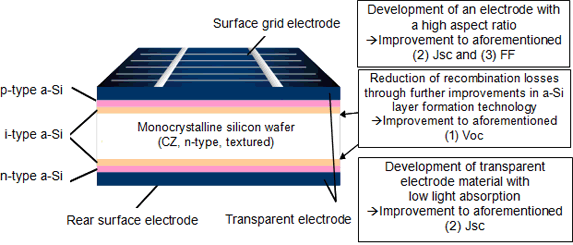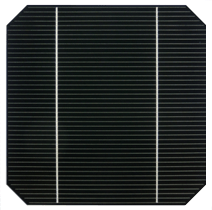Osaka, Japan - Panasonic Corporation today announced it has achieved a record conversion efficiency of 24.7%*1 at the research level, using its HIT® solar cell at 98 μm thickness. The rate is the world's highest*2 for any crystalline silicon-based solar cell of practical size (100 cm² and above).
This record conversion rate demonstrates superb efficiency of Panasonic HIT solar cells to convert sunlight into electricity. The latest figure is 0.8 percentage points higher than the previous record (23.9%) for HIT solar cells, and 0.5 percentage points higher than the previously published record*3 for any monocrystalline silicon-based solar cell of practical size (100 cm² and above).
Further, achieving this high efficiency at the very thin thickness of 98 μm has significant implications in terms of cost reduction as Panasonic continues to improve efficiency of its solar cells while lowering costs, with the aim to set itself apart from other companies in the industry.
♦ Core technologies behind the record efficiency rating
(1) Reduction in recombination loss
A key feature of HIT solar cells is the lamination of a high-quality amorphous silicon layer onto the surface of the monocrystalline silicon substrate that serves as the power-generating layer. This leads to a reduction in recombination loss*4 within the electrical elements, known as carriers*5. To further enhance this unique property of HIT solar cells, Panasonic has developed a new technology that enables to form on the monocrystalline silicon substrate an amorphous silicon layer of even higher quality while limiting damage to the surface of the substrate. This has enabled a further reduction of recombination losses within the carrier. As a result, the open voltage (Voc)*6 has been improved from 0.748 V to 0.750 V.
(2) Reduction in optical loss
In order to achieve a high electrical current from solar cells, it is necessary to induce the solar rays arriving at the cell surface into the monocrystalline silicon substrate that serves as the power-generating layer with as little losses as possible. This time, using a HIT solar cell, Panasonic has successfully reduced absorption loss of light in the transparent conductive coatings and the amorphous silicon layer covering the monocrystalline silicon substrate. At the same time, shading loss has also been decreased by reducing the surface area of the grid electrode on the cell surface. As a result, density of the short-circuit current (Jsc)*7 has been improved from 38.9 mA/cm² to 39.5 mA/cm².
(3) Reduction in resistive loss
In solar cells, the electrical current generated is accumulated within the grid electrode on the cell surface and then delivered outside. This time, Panasonic has succeeded in cutting down resistive loss that occurs when an electric current passes through the grid electrode by improving the grid electrode, including the development of an electrode with a higher aspect ratio*8. As a result, the fill factor (FF)*9 has been improved from 0.822 to 0.832.
Panasonic will focus on applying this newly-developed high-efficiency technology to mass production products, and will continue to develop technologies that improve efficiency, reduce costs, and save resources further.
♦ Properties of HIT solar cells
| Open voltage (Voc) | 0.750 V |
| Short-circuit current (Isc) [short-circuit current density (Jsc)]*7 | 4.02 A [39.5 mA/cm²] |
| Fill factor (FF)*9 | 0.832 |
| Cell transfer efficiency | 24.7% |
| Cell surface area | 101.8 cm² |
♦ Core technology diagram

♦ Outer appearance

*1 As evaluated by the National Institute of Advanced Industrial Science and Technology
*2 As of February 12, 2013 (Panasonic survey)
*3 As determined from "Solar cell efficiency tables (version 41)" [Prog. Photovolt: Res. Appl. 2013; 21:1-11]
*4 Recombination loss refers to a reduction in current and voltage output from the solar cell caused by positive and negative electrical charge (carriers) generated within the solar cell then combining within the solar cell and thus cancelling out.
*5 Carriers are comprised of two types of electrical particles-electrons (negative) and holes (positive). While electrons carry a negative charge, holes are effectively empty shells without electrons and thus carry a positive charge.
*6 Open voltage (Voc) is the maximum voltage generated by the solar cell. Short-circuit current density (Jsc) is calculated by dividing Isc by the surface area of the cell.
*7 Short-circuit current (Isc) is the maximum current generated by the solar cell.
*8 A higher aspect ratio refers to a higher ratio of height to line width within the grid electrode. Since the grid electrode serves to block light entering the cell surface, a higher aspect ratio serves to reduce such losses and to lower resistance within the electrode grid.
*9 Fill factor (FF) is a value calculated by dividing the maximum output of the solar cell by the product of the open voltage and short-circuit voltage.
About Panasonic
Panasonic Corporation is a worldwide leader in the development and manufacture of electronic products in three business fields, consumer, components & devices, and solutions. Based in Osaka, Japan, the company recorded consolidated net sales of 7.85 trillion yen for the year ended March 31, 2012. Panasonic's stock is listed on the Tokyo, Osaka, Nagoya and New York (NYSE:PC) Stock Exchanges. The company has the vision of becoming the No. 1 Green Innovation Company in the Electronics Industry by the 100th year of its founding in 2018. For more information on Panasonic, its brand and commitment to sustainability, visit the company's website at http://panasonic.net/.
Media Contacts:
- Tokyo Public Relations Office
Panasonic Corporation - Tel: +81-(0)3-3574-5664 Fax: +81-(0)3-3574-5699
- Panasonic News Bureau
- Tel: +81-(0)3-3542-6205 Fax: +81-(0)3-3542-9018





![[Video] TOYOTA ARENA TOKYO is born! Where next-gen sports experiences happen](http://news.panasonic.com/uploads/tmg_block_page/cover_image/18092/tat-main.jpg)
